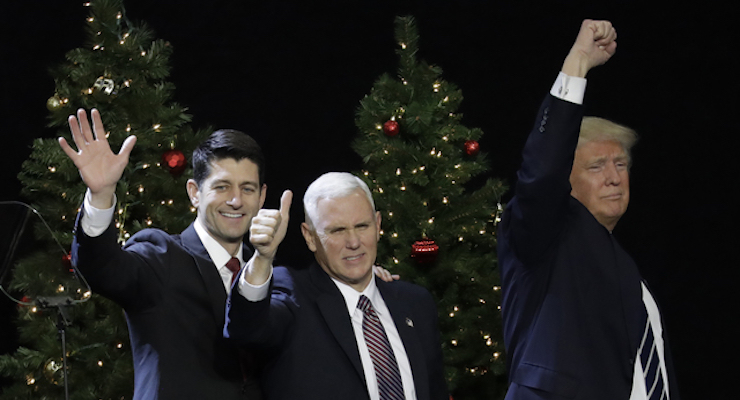

President-elect Donald Trump, Vice-President-elect Mike Pence and House Speaker Paul Ryan wave at a rally Tuesday, Dec. 13, 2016, in West Allis, Wis. (Photo: AP)
In the world of tax policy, there’s an intense debate about the “border-adjustable” provision that is part of the tax plan put forth by House Republicans, which basically would tax imports and exempt revenues generated by exports.
It’s a bit wonky, but the simplest explanation is that GOPers want to replace the current corporate income tax with a “destination-based cash flow tax” (DBCFT) that would – for all intents and purposes – tax what is consumed in the United States rather than what is produced in the United States.
I’m very sympathetic to what Republicans are trying to accomplish, particularly their desire to eliminate the tax bias against income that is saved and invested. But I greatly prefer the version of consumption-base taxation found in the flat tax.
My previous columns on the plan have highlighted the following concerns.
- Left-leaning advocates like “destination-based” tax systems such as the DBCFT because such systems undermine tax competition and give politicians more ability to increase tax rates.
- The “border adjustability” in the plan is contrary to the rules of the World Trade Organization (WTO) and there’s a significant risk that politicians might try to “fix” the plan by turning it into a value-added tax.
Here’s what I said about the proposal in a recent interview for CNBC.
VIDEO
This provision is not in Trump’s plan, but I’ve been acting on the assumption that the soon-to-be President eventually would embrace the Better Way Plan simply because it presumably would appeal to his protectionist sentiments.
So I’m quite surprised that he’s just poured cold water on the plan. Here are some excerpts from a report in the Wall Street Journal.
President-elect Donald Trump criticized a cornerstone of House Republicans’ corporate-tax plan… The measure, known as border adjustment, would tax imports and exempt exports as part of a broader plan to encourage companies to locate jobs and production in the U.S. But Mr. Trump, in his first comments on the subject, called it “too complicated.” “Anytime I hear border adjustment, I don’t love it,” Mr. Trump said in an interview with The Wall Street Journal on Friday. …Retailers and oil refiners have lined up against the measure, warning it would drive up their tax bills and force them to raise prices because they rely so heavily on imported goods.
If we read between the lines, it appears that Trump may be more knowledgeable about policy than people think.
Proponents of the Better Way Plan sometimes use protectionist-sounding rhetoric to sell the plan (e.g., taxing imports, exempting exports), but they argue that it’s not really protectionist because the dollar will become more valuable.
But Trump apparently understands this nuance and doesn’t like that outcome.
Independent analyses of the Republican tax plan say it would lead the dollar to appreciate further—which would lower the cost of imported goods, offsetting the effects of the tax on retailers and others. In his interview with the Journal on Friday, Mr. Trump said the U.S. dollar was already “too strong” in part because China holds down its currency, the yuan. “Our companies can’t compete with them now because our currency is too strong. And it’s killing us.”
I don’t agree with Trump about trade deficits (which, after all, are mostly the result of foreigners wanting to invest in the American economy), but that’s a separate issue.
When I talk to policy makers and journalists about this issue, one of the most common questions is why the DBCFT would cause the dollar to rise.
In a column for the Wall Street Journal, Martin Feldstein addresses that topic.
…as every student of economics learns, a country’s trade deficit depends only on the difference between total investment in the country and the saving done by its households, businesses and government. This textbook rule that “imports minus exports equals investment minus savings” is not a theory or a statistical regularity but a basic national income accounting identity that holds for every country in every year. That holds because a rise in a country’s investment without an equal rise in saving means that it must import more or export less. Since a border tax adjustment wouldn’t change U.S. national saving or investment, it cannot change the size of the trade deficit. To preserve that original trade balance, the exchange rate of the dollar must adjust to bring the prices of U.S. imports and exports back to the values that would prevail without the border tax adjustment. With a 20% corporate tax rate, that means that the value of the dollar must rise by 25%.
This is a reasonable description, though keep in mind that there are lots of factors that drive exchange rates, so I understand why importers are very nervous about the proposal.
By the way, Feldstein makes one point that rubs me the wrong way.
The tax plan developed by the House Republicans is similar in many ways to President-elect Trump’s plan but has one additional favorable feature—a border tax adjustment that exempts exports and taxes imports. This would give the U.S. the benefit that other countries obtain from a value-added tax (VAT) but without imposing that extra levy on domestic transactions.
The first sentence of the excerpt is correct, but not the second one. A value-added tax does not give nations any sort of trade benefit. Yes, that kind of tax generally is “border adjustable” under WTO rules, but as I’ve previously noted, that doesn’t give foreign production an advantage over American production.
Here’s some of what I wrote about this issue last year.
For mercantilists worried about trade deficits, “border adjustability” is seen as a positive feature. But not only are they wrong on trade, they do not understand how a VAT works. …Under current law, American goods sold in America do not pay a VAT, but neither do German-produced goods that are sold in America. Likewise, any American-produced goods sold in Germany are hit be a VAT, but so are German-produced goods. In other words, there is a level playing field. The only difference is that German politicians seize a greater share of people’s income. So what happens if America adopts a VAT? The German government continues to tax American-produced goods in Germany, just as it taxes German-produced goods sold in Germany. …In the United States, there is a similar story. There is now a tax on imports, including imports from Germany. But there is an identical tax on domestically-produced goods. And since the playing field remains level, protectionists will be disappointed. The only winners will be politicians since they have more money to spend.
If you want more information, I also discuss the trade impact of a VAT in this video.
For what it’s worth, even Paul Krugman agrees with me on this point.






